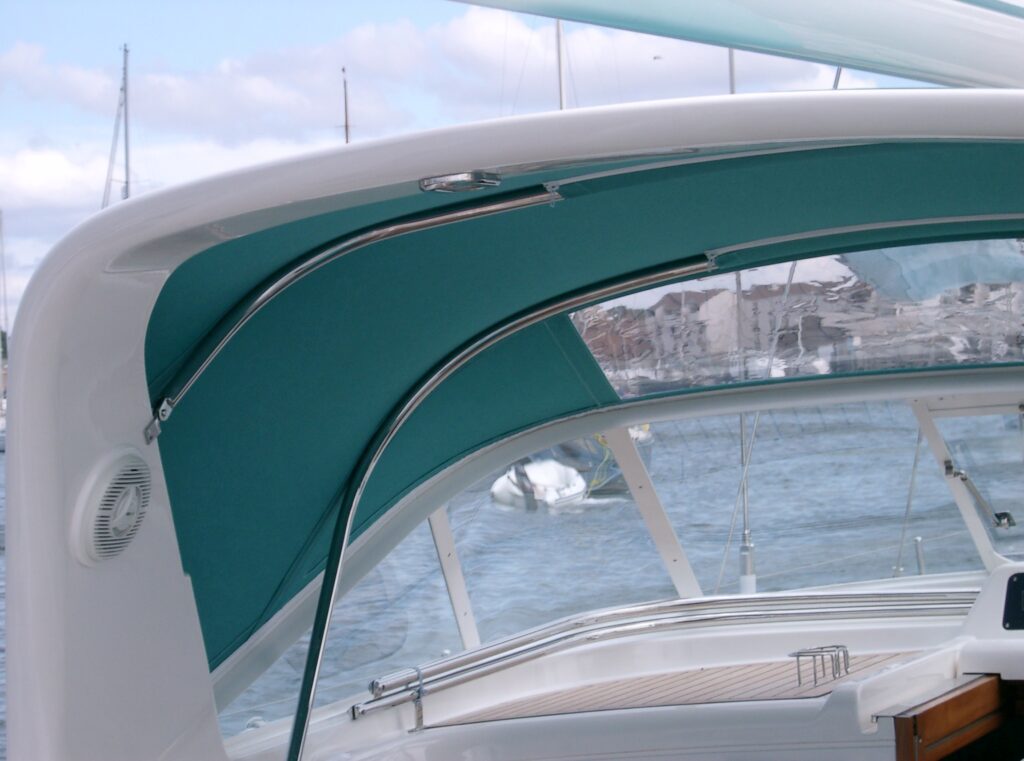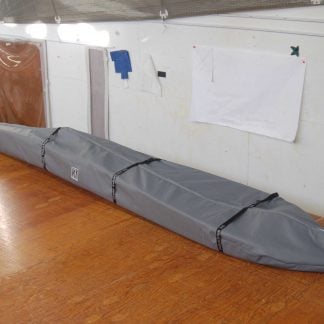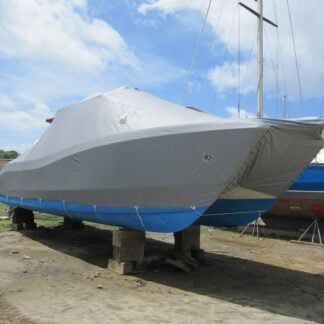MAR 3, 2025
Marine canvas is a durable and essential material used in various boat accessories such as covers, biminis, dodgers, and cushions. It protects from the sun, rain, and wind, making your time on the water more enjoyable and ensuring your boat’s longevity. However, like any outdoor material, marine canvas requires proper care and maintenance to stay in top shape. Here are some helpful tips on how to care for your marine canvas to increase its lifespan.
1. Regular Cleaning: The First Line of Defense

Keeping your marine canvas clean is one of the most effective ways to preserve its appearance and integrity. Dirt, salt, and grime can all contribute to the breakdown of the fabric over time if left unchecked.
How to clean your marine canvas:
- Use mild soap and water: Start by brushing off loose dirt and debris with a soft brush. Then, wash the fabric with a solution of mild soap (like dish soap) and warm water. Avoid harsh chemicals, which can degrade the fabric’s protective coating.
- Use a soft cloth or sponge: Gently scrub the fabric with a sponge or soft cloth. Avoid using abrasive materials that could scratch the canvas.
- Rinse thoroughly: Make sure to rinse the canvas thoroughly with fresh water to remove all soap residue.
- Dry properly: Allow the canvas to air dry completely before folding or storing it to prevent mildew growth. Hanging the canvas in a well-ventilated area is ideal.
2. Protect Against Mold and Mildew
Marine environments are ideal for mold and mildew to grow, particularly when fabric remains damp for prolonged periods. This can lead to unpleasant odors, discoloration, and deterioration of the fabric.
To prevent mold and mildew:
- Dry the canvas thoroughly: After exposure to rain or humidity, always make sure your canvas is completely dry before folding or storing it.
- Use mildew-resistant products: There are specialized mildew-resistant sprays available for marine canvas. Apply these to your fabric as recommended to inhibit mold growth.
- Clean with vinegar solution: If you spot any mildew, you can clean the affected area with a solution of white vinegar and water. Scrub gently and rinse thoroughly.
3. Reapply Waterproofing Coatings
One of the major reasons for choosing marine canvas is its waterproof properties. Over time, however, exposure to sun, rain, and saltwater can cause the fabric’s waterproofing to wear away. Reapplying a waterproofing spray will help keep your canvas in top condition.
How to maintain waterproofing:
- Use a marine-grade waterproofing spray: After cleaning and drying your canvas, apply a marine-grade waterproofing spray to restore its resistance to water. Be sure to follow the manufacturer’s instructions carefully for best results.
- Focus on seams and stitching: Pay special attention to seams and stitching, as these areas are more vulnerable to water penetration. Many waterproofing sprays offer added protection for seams.
4. UV Protection is Key
The sun’s harmful UV rays can break down the fibers of marine canvas over time, leading to fading, brittleness, and eventual failure of the fabric. UV protection treatments help prevent this damage and keep your canvas looking fresh.
How to protect from UV damage:
- Use UV-protective spray: UV protection sprays designed for marine canvas help block harmful rays and protect the fabric from premature aging.
- Store or cover your canvas when not in use: If possible, store your canvas in a shaded area or cover it when your boat is not in use for extended periods. This reduces direct exposure to the sun.
- Choose a high-quality canvas: Some canvas materials are inherently better at resisting UV damage. If you’re purchasing new marine canvas, consider investing in a UV-resistant fabric to extend the life of your boat accessories.
5. Repair Damage Promptly
Marine canvas, like any fabric, can suffer wear and tear. It’s important to address any issues promptly before they worsen, as small rips or holes can lead to larger, more expensive problems down the road.
Repair tips:
- Use a patch kit: For minor tears, rips, or holes, apply a patch using a marine-grade canvas repair kit. These kits typically include adhesive patches that match the fabric, ensuring a smooth and durable repair.
- Stitch larger tears: For more substantial damage, you may need to sew the tear using a strong, UV-resistant thread. If you’re unsure, consider taking the item to a professional canvas repair specialist.
6. Proper Storage
When not in use, storing your marine canvas properly is just as important as caring for it during the boating season. Proper storage prevents damage from environmental factors like sun, rain, and pests.
How to store marine canvas:
- Clean and dry thoroughly: Before storing your canvas, ensure it’s completely clean and dry. Any leftover moisture can lead to mildew and odor during storage.
- Store in a cool, dry place: Ideally, store your canvas in a dry, cool, and dark place. Avoid folding it in a damp or humid environment, as this can lead to mold growth.
- Avoid tight storage: When folding your canvas, avoid folding it too tightly, as this can cause creases and stress on the fabric. If possible, hang the canvas in a storage bag or container to prevent crushing.
Conclusion
Caring for your marine canvas is essential for ensuring it remains strong, functional, and visually appealing for years to come. Regular cleaning, protecting against UV rays and mildew, applying waterproofing treatments, and promptly addressing any damage can significantly extend the life of your boat’s canvas accessories. With a little effort and attention, your marine canvas can continue to serve you well, keeping your boat looking great and performing at its best.




